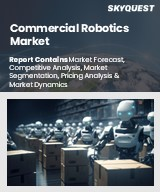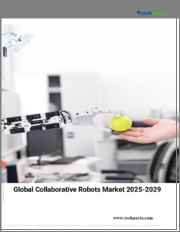
|
시장보고서
상품코드
1594170
모바일 코봇 시장 : 중량 용량, 용도, 최종 용도 산업별 - 세계 예측(2025-2030년)Mobile Cobots Market by Weight Capacity (1 to 3 Kg, 3 to 5 Kg, 5 to 10 Kg), Application (Automated Pallet Forks, Conveyor Bands/Belts, Robotic Arms), End-use Industry - Global Forecast 2025-2030 |
||||||
모바일 코봇 시장의 2023년 시장 규모는 15억 4,000만 달러로, 2024년에는 18억 6,000만 달러에 달할 것으로 예측되며, CAGR 21.84%로 성장하며, 2030년에는 61억 6,000만 달러에 달할 것으로 예측됩니다.
모바일 협동 로봇(모바일 코봇)은 유연성과 안전성을 유지하면서 반복적인 작업을 자동화하여 생산성을 향상시키고 인간과 함께 작업하도록 설계되었습니다. 이러한 코봇은 제조, 물류, 의료 등의 산업에서 필수적이며, 자재 취급, 조립, 적응성과 인간과 로봇의 상호 작용이 필요한 정밀한 작업을 지원합니다. 노동력 부족을 해결하고 효율성을 높이기 위해 자동화가 진행됨에 따라 모바일 코봇에 대한 수요는 증가하는 추세입니다. 주요 성장 요인으로는 코봇 기능을 강화하는 AI 및 머신러닝의 발전, 인더스트리 4.0 관행의 확산, 유연한 제조 공정을 필요로 하는 대량 맞춤화 추세 등이 있습니다. 이러한 원동력에도 불구하고 높은 초기 투자 비용, 기술의 복잡성, 안전 기준 준수 등의 과제는 여전히 남아있습니다. 또한 코봇 통합에 대한 인식과 교육이 제한적이라는 점도 시장 침투에 걸림돌로 작용할 수 있습니다. 새로운 비즈니스 기회는 중소기업(SME)에 맞게 조정된 사용자 친화적이고 확장 가능한 코봇 개발에서 찾을 수 있습니다. 자율적 탐색과 의사결정을 강화하는 AI 혁신은 코봇의 범위와 효율성을 높일 수 있습니다. 또한 코봇과 기존 시스템과의 상호 운용성을 개선하고 원활한 통합을 촉진하는 데 중점을 둔 연구도 가능합니다. 급속한 산업화가 진행되고 있는 신흥 시장으로의 지역적 확장은 미개척 가능성을 보여주고 있습니다. 또한 공동 연구를 통해 실시간 데이터 처리와 배터리 수명 문제를 해결하면 성장 전망이 밝습니다. 시장 역학에 대한 미묘한 이해로 경쟁 구도이 명확해지면서 각 회사는 제품 제공을 강화하기 위해 연구개발에 투자하고 있습니다. 기업은 기술 발전을 위해 하이테크 기업과 파트너십을 맺고, 최종사용자를 위한 기술 교육에 투자하여 채택률을 높이고, 특정 산업에 맞게 솔루션을 맞춤화해야 한다고 조언했습니다. 시장 상황을 효과적으로 탐색하고 마케팅 전략에서 비용 효율성을 강조하는 것도 성장을 가속할 수 있는 방법입니다.
| 주요 시장 통계 | |
|---|---|
| 기준년[2023년] | 15억 4,000만 달러 |
| 예측년[2024년] | 18억 6,000만 달러 |
| 예측년[2030년] | 61억 6,000만 달러 |
| CAGR(%) | 21.84% |
시장 역학: 빠르게 진화하는 모바일 코봇 시장의 주요 시장 인사이트 공개
모바일 코봇 시장은 수요 및 공급의 역동적인 상호작용을 통해 변화하고 있습니다. 이러한 시장 역학의 진화를 이해함으로써 기업은 정보에 입각한 투자 결정, 전략적 의사결정, 새로운 비즈니스 기회를 포착할 수 있습니다. 이러한 동향을 종합적으로 파악함으로써 기업은 정치적, 지역적, 기술적, 사회적, 경제적 영역 전반에 걸친 다양한 리스크를 줄일 수 있으며, 소비자 행동과 그것이 제조 비용 및 구매 동향에 미치는 영향을 보다 명확하게 이해할 수 있습니다.
- 시장 성장 촉진요인
- 산업 자동화를 향한 기울기 증가
- 모바일 코봇의 정확도 향상 및 비용 절감
- 설비 투자를 통한 업스트림 및 다운스트림 공정의 에너지 절감 가능성
- 시장 성장 억제요인
- 모바일 코봇과 관련된 안전 문제
- 시장 기회
- 기술의 발전과 기계 수 증가
- 자동차 산업 및 농업 부문에서 모바일 코봇에 대한 수요 증가
- 혁신적인 시각 기술 활용
- 시장 과제
- 숙련공 부족
Porter's Five Forces: 모바일 코봇 시장 공략을 위한 전략 툴
Portre's Five Forces: 모바일 코봇 시장 경쟁 구도를 이해하는 데 중요한 툴입니다. Porter의 Five Forces 프레임워크는 기업의 경쟁을 평가하고 전략적 기회를 모색하기 위한 명확한 방법을 설명합니다. 이 프레임워크는 기업이 시장내 세력도를 평가하고 신규 사업의 수익성을 판단하는 데 도움이 됩니다. 이러한 인사이트를 통해 기업은 강점을 활용하고 약점을 보완하며 잠재적 도전을 피함으로써 보다 강력한 시장 포지셔닝을 확보할 수 있습니다.
PESTLE 분석 : 모바일 코봇 시장의 외부 영향 파악
외부 거시 환경 요인은 모바일 코봇 시장의 성과 역학을 형성하는 데 매우 중요한 역할을 합니다. 정치적, 경제적, 사회적, 기술적, 법적, 환경적 요인에 대한 분석은 이러한 영향을 탐색하는 데 필요한 정보를 담고 있으며, PESTLE 요인을 조사함으로써 기업은 잠재적인 위험과 기회를 더 잘 이해할 수 있습니다. 이러한 분석을 통해 기업은 규제, 소비자 선호도, 경제 동향의 변화를 예측하고 선제적이고 적극적인 의사결정을 내릴 준비를 할 수 있습니다.
시장 점유율 분석 : 모바일 코봇 시장 경쟁 구도 파악
모바일 코봇 시장의 상세한 시장 점유율 분석을 통해 벤더의 성과를 종합적으로 평가할 수 있습니다. 기업은 매출, 고객 기반, 성장률 등 주요 지표를 비교하여 경쟁적 포지셔닝을 파악할 수 있습니다. 이 분석은 시장의 집중화, 세분화 및 통합 추세를 파악하여 공급업체가 치열한 경쟁에서 자신의 입지를 강화할 수 있는 전략적 의사결정을 내리는 데 필요한 인사이트를 제공합니다.
FPNV 포지셔닝 매트릭스: 모바일 코봇 시장에서공급업체 성과 평가
FPNV 포지셔닝 매트릭스는 모바일 코봇 시장에서 벤더를 평가할 수 있는 중요한 툴입니다. 이 매트릭스를 통해 비즈니스 조직은 벤더의 비즈니스 전략과 제품 만족도를 기반으로 평가하여 목표에 부합하는 정보에 입각한 의사결정을 내릴 수 있으며, 4개의 사분면으로 벤더를 명확하고 정확하게 세분화하여 전략 목표에 가장 적합한 파트너와 솔루션을 식별할 수 있습니다. 전략 목표에 가장 적합한 파트너와 솔루션을 식별할 수 있습니다.
전략 분석 및 추천: 모바일 코봇 시장에서 성공으로 가는 길 차트
모바일 코봇 시장 전략 분석은 세계 시장에서의 입지를 강화하고자 하는 기업에게 필수적입니다. 주요 자원, 역량 및 성과 지표를 검토함으로써 기업은 성장 기회를 파악하고 개선할 수 있습니다. 이러한 접근 방식은 경쟁 환경의 도전을 극복하고 새로운 비즈니스 기회를 활용하여 장기적인 성공을 거둘 수 있는 체계를 구축할 수 있도록 도와줍니다.
이 보고서는 주요 관심 부문에 대한 종합적인 시장 분석을 제공합니다.
1. 시장 침투도 : 현재 시장 환경의 상세한 검토, 주요 기업의 광범위한 데이터, 시장 도달 범위 및 전반적인 영향력을 평가합니다.
2. 시장 개척도: 신흥 시장에서의 성장 기회를 파악하고, 기존 부문의 확장 가능성을 평가하며, 미래 성장을 위한 전략적 로드맵을 기술하고 있습니다.
3. 시장 다각화 : 최근 제품 출시, 미개척 지역, 산업의 주요 발전, 시장을 형성하는 전략적 투자를 분석합니다.
4. 경쟁 평가 및 정보 : 경쟁 구도를 철저히 분석하여 시장 점유율, 사업 전략, 제품 포트폴리오, 인증, 규제 당국의 승인, 특허 동향, 주요 기업의 기술 발전 등을 검토합니다.
5. 제품 개발 및 혁신 : 미래 시장 성장을 가속할 것으로 예상되는 첨단 기술, 연구개발 활동 및 제품 혁신을 강조합니다.
또한 이해관계자들이 충분한 정보를 바탕으로 의사결정을 내릴 수 있도록 중요한 질문에 대한 답변도 제공합니다.
1. 현재 시장 규모와 향후 성장 전망은?
2. 최고의 투자 기회를 제공하는 제품, 지역은?
3. 시장을 형성하는 주요 기술 동향과 규제의 영향은?
4. 주요 벤더 시장 점유율과 경쟁 포지션은?
5. 벤더 시장 진입 및 철수 전략의 원동력이 되는 수입원과 전략적 기회는 무엇인가?
목차
제1장 서문
제2장 조사 방법
제3장 개요
제4장 시장 개요
제5장 시장 인사이트
- 시장 역학
- 성장 촉진요인
- 성장 억제요인
- 기회
- 과제
- 시장 세분화 분석
- Porter's Five Forces 분석
- PESTEL 분석
- 정치
- 경제
- 사회
- 기술
- 법률
- 환경
제6장 모바일 코봇 시장 : 중량 용량별
- 서론
- 1-3kg
- 3-5kg
- 5-10kg
- 10kg 이상
제7장 모바일 코봇 시장 : 용도별
- 서론
- 자동 파렛트 포크
- 컨베이어 밴드/벨트
- 로봇 암
- 안전 유닛
- 선반 유닛
제8장 모바일 코봇 시장 : 최종 용도 산업별
- 서론
- 항공우주
- 농업
- 자동차
- 건설
- 일렉트로닉스와 반도체
- 식품 및 음료
- 의료
- 소매·물류
제9장 아메리카의 모바일 코봇 시장
- 서론
- 아르헨티나
- 브라질
- 캐나다
- 멕시코
- 미국
제10장 아시아태평양의 모바일 코봇 시장
- 서론
- 호주
- 중국
- 인도
- 인도네시아
- 일본
- 말레이시아
- 필리핀
- 싱가포르
- 한국
- 대만
- 태국
- 베트남
제11장 유럽, 중동 및 아프리카의 모바일 코봇 시장
- 서론
- 덴마크
- 이집트
- 핀란드
- 프랑스
- 독일
- 이스라엘
- 이탈리아
- 네덜란드
- 나이지리아
- 노르웨이
- 폴란드
- 카타르
- 러시아
- 사우디아라비아
- 남아프리카공화국
- 스페인
- 스웨덴
- 스위스
- 터키
- 아랍에미리트
- 영국
제12장 경쟁 구도
- 시장 점유율 분석, 2023년
- FPNV 포지셔닝 매트릭스, 2023년
- 경쟁 시나리오 분석
- 전략 분석과 제안
언급된 기업
- ABB
- AUBO Robotics USA
- FANUC Corporation
- Kawasaki Heavy Industries Ltd.
- KUKA
- Rethink Robotics
- Robert Bosch GmbH
- TECHMAN Robots
- The Yaskawa Electric Corporation
- Universal Robots
The Mobile Cobots Market was valued at USD 1.54 billion in 2023, expected to reach USD 1.86 billion in 2024, and is projected to grow at a CAGR of 21.84%, to USD 6.16 billion by 2030.
Mobile collaborative robots, or mobile cobots, are designed to work alongside humans, enhancing productivity by automating repetitive tasks while maintaining flexibility and safety. These cobots are essential in industries such as manufacturing, logistics, and healthcare, where they assist with material handling, assembly, and precise operations that require adaptability and human-robot interaction. As industries increasingly automate to combat labor shortages and improve efficiency, the demand for mobile cobots is poised to grow. Critical growth factors include advancements in AI and machine learning that enhance cobot capabilities, increasing adoption of Industry 4.0 practices, and the trend toward mass customization that necessitates flexible manufacturing processes. Despite these drivers, challenges such as high initial investments, technological complexity, and safety standards compliance remain. Additionally, limited awareness and training availability regarding cobot integration can hinder market penetration. Emerging opportunities lie in developing user-friendly, scalable cobots tailored for small and medium-sized enterprises (SMEs). Innovating in AI to enhance autonomous navigation and decision-making can enhance the scope and effectiveness of cobots. Research can also focus on improving interoperability between cobots and existing systems, fostering seamless integration. Geographical expansion into emerging markets, where rapid industrialization is underway, represents untapped potential. Additionally, addressing the challenges of real-time data processing and mobile cobots' battery life through collaborative research offers growth prospects. A nuanced understanding of market dynamics reveals a competitive landscape, with players investing in R&D to enhance product offerings. Recommendations for businesses include forming partnerships with tech firms for technological advancements, investing in skills training for end-users to increase adoption rates, and tailoring solutions to specific industry verticals. Navigating regulatory landscapes effectively and emphasizing the cost-benefit ratio in marketing strategies can also catalyze growth, making mobile cobots a strategic investment in future-proofing operations across industries.
| KEY MARKET STATISTICS | |
|---|---|
| Base Year [2023] | USD 1.54 billion |
| Estimated Year [2024] | USD 1.86 billion |
| Forecast Year [2030] | USD 6.16 billion |
| CAGR (%) | 21.84% |
Market Dynamics: Unveiling Key Market Insights in the Rapidly Evolving Mobile Cobots Market
The Mobile Cobots Market is undergoing transformative changes driven by a dynamic interplay of supply and demand factors. Understanding these evolving market dynamics prepares business organizations to make informed investment decisions, refine strategic decisions, and seize new opportunities. By gaining a comprehensive view of these trends, business organizations can mitigate various risks across political, geographic, technical, social, and economic domains while also gaining a clearer understanding of consumer behavior and its impact on manufacturing costs and purchasing trends.
- Market Drivers
- Growing inclination towards industry automation
- Improvement in accuracy and declining cost of mobile cobots
- Potential energy savings in the upstream and downstream processes forced by investments in capital equipment
- Market Restraints
- Safety issues associated with mobile cobots
- Market Opportunities
- Technological advancements and rising number of machineries
- Increasing demand for mobile cobots from automotive industry and agricultural applications
- Utilization of innovative visual technology
- Market Challenges
- Dearth of skilled workers
Porter's Five Forces: A Strategic Tool for Navigating the Mobile Cobots Market
Porter's five forces framework is a critical tool for understanding the competitive landscape of the Mobile Cobots Market. It offers business organizations with a clear methodology for evaluating their competitive positioning and exploring strategic opportunities. This framework helps businesses assess the power dynamics within the market and determine the profitability of new ventures. With these insights, business organizations can leverage their strengths, address weaknesses, and avoid potential challenges, ensuring a more resilient market positioning.
PESTLE Analysis: Navigating External Influences in the Mobile Cobots Market
External macro-environmental factors play a pivotal role in shaping the performance dynamics of the Mobile Cobots Market. Political, Economic, Social, Technological, Legal, and Environmental factors analysis provides the necessary information to navigate these influences. By examining PESTLE factors, businesses can better understand potential risks and opportunities. This analysis enables business organizations to anticipate changes in regulations, consumer preferences, and economic trends, ensuring they are prepared to make proactive, forward-thinking decisions.
Market Share Analysis: Understanding the Competitive Landscape in the Mobile Cobots Market
A detailed market share analysis in the Mobile Cobots Market provides a comprehensive assessment of vendors' performance. Companies can identify their competitive positioning by comparing key metrics, including revenue, customer base, and growth rates. This analysis highlights market concentration, fragmentation, and trends in consolidation, offering vendors the insights required to make strategic decisions that enhance their position in an increasingly competitive landscape.
FPNV Positioning Matrix: Evaluating Vendors' Performance in the Mobile Cobots Market
The Forefront, Pathfinder, Niche, Vital (FPNV) Positioning Matrix is a critical tool for evaluating vendors within the Mobile Cobots Market. This matrix enables business organizations to make well-informed decisions that align with their goals by assessing vendors based on their business strategy and product satisfaction. The four quadrants provide a clear and precise segmentation of vendors, helping users identify the right partners and solutions that best fit their strategic objectives.
Strategy Analysis & Recommendation: Charting a Path to Success in the Mobile Cobots Market
A strategic analysis of the Mobile Cobots Market is essential for businesses looking to strengthen their global market presence. By reviewing key resources, capabilities, and performance indicators, business organizations can identify growth opportunities and work toward improvement. This approach helps businesses navigate challenges in the competitive landscape and ensures they are well-positioned to capitalize on newer opportunities and drive long-term success.
Key Company Profiles
The report delves into recent significant developments in the Mobile Cobots Market, highlighting leading vendors and their innovative profiles. These include ABB, AUBO Robotics USA, FANUC Corporation, Kawasaki Heavy Industries Ltd., KUKA, Rethink Robotics, Robert Bosch GmbH, TECHMAN Robots, The Yaskawa Electric Corporation, and Universal Robots.
Market Segmentation & Coverage
This research report categorizes the Mobile Cobots Market to forecast the revenues and analyze trends in each of the following sub-markets:
- Based on Weight Capacity, market is studied across 1 to 3 Kg, 3 to 5 Kg, 5 to 10 Kg, and Above 10 Kg.
- Based on Application, market is studied across Automated Pallet Forks, Conveyor Bands/Belts, Robotic Arms, Safety Units, and Shelf Units.
- Based on End-use Industry, market is studied across Aerospace, Agriculture, Automotive, Construction, Electronics & Semiconductor, Food & Beverages, Healthcare, and Retail & Logistics.
- Based on Region, market is studied across Americas, Asia-Pacific, and Europe, Middle East & Africa. The Americas is further studied across Argentina, Brazil, Canada, Mexico, and United States. The United States is further studied across California, Florida, Illinois, New York, Ohio, Pennsylvania, and Texas. The Asia-Pacific is further studied across Australia, China, India, Indonesia, Japan, Malaysia, Philippines, Singapore, South Korea, Taiwan, Thailand, and Vietnam. The Europe, Middle East & Africa is further studied across Denmark, Egypt, Finland, France, Germany, Israel, Italy, Netherlands, Nigeria, Norway, Poland, Qatar, Russia, Saudi Arabia, South Africa, Spain, Sweden, Switzerland, Turkey, United Arab Emirates, and United Kingdom.
The report offers a comprehensive analysis of the market, covering key focus areas:
1. Market Penetration: A detailed review of the current market environment, including extensive data from top industry players, evaluating their market reach and overall influence.
2. Market Development: Identifies growth opportunities in emerging markets and assesses expansion potential in established sectors, providing a strategic roadmap for future growth.
3. Market Diversification: Analyzes recent product launches, untapped geographic regions, major industry advancements, and strategic investments reshaping the market.
4. Competitive Assessment & Intelligence: Provides a thorough analysis of the competitive landscape, examining market share, business strategies, product portfolios, certifications, regulatory approvals, patent trends, and technological advancements of key players.
5. Product Development & Innovation: Highlights cutting-edge technologies, R&D activities, and product innovations expected to drive future market growth.
The report also answers critical questions to aid stakeholders in making informed decisions:
1. What is the current market size, and what is the forecasted growth?
2. Which products, segments, and regions offer the best investment opportunities?
3. What are the key technology trends and regulatory influences shaping the market?
4. How do leading vendors rank in terms of market share and competitive positioning?
5. What revenue sources and strategic opportunities drive vendors' market entry or exit strategies?
Table of Contents
1. Preface
- 1.1. Objectives of the Study
- 1.2. Market Segmentation & Coverage
- 1.3. Years Considered for the Study
- 1.4. Currency & Pricing
- 1.5. Language
- 1.6. Stakeholders
2. Research Methodology
- 2.1. Define: Research Objective
- 2.2. Determine: Research Design
- 2.3. Prepare: Research Instrument
- 2.4. Collect: Data Source
- 2.5. Analyze: Data Interpretation
- 2.6. Formulate: Data Verification
- 2.7. Publish: Research Report
- 2.8. Repeat: Report Update
3. Executive Summary
4. Market Overview
5. Market Insights
- 5.1. Market Dynamics
- 5.1.1. Drivers
- 5.1.1.1. Growing inclination towards industry automation
- 5.1.1.2. Improvement in accuracy and declining cost of mobile cobots
- 5.1.1.3. Potential energy savings in the upstream and downstream processes forced by investments in capital equipment
- 5.1.2. Restraints
- 5.1.2.1. Safety issues associated with mobile cobots
- 5.1.3. Opportunities
- 5.1.3.1. Technological advancements and rising number of machineries
- 5.1.3.2. Increasing demand for mobile cobots from automotive industry and agricultural applications
- 5.1.3.3. Utilization of innovative visual technology
- 5.1.4. Challenges
- 5.1.4.1. Dearth of skilled workers
- 5.1.1. Drivers
- 5.2. Market Segmentation Analysis
- 5.3. Porter's Five Forces Analysis
- 5.3.1. Threat of New Entrants
- 5.3.2. Threat of Substitutes
- 5.3.3. Bargaining Power of Customers
- 5.3.4. Bargaining Power of Suppliers
- 5.3.5. Industry Rivalry
- 5.4. PESTLE Analysis
- 5.4.1. Political
- 5.4.2. Economic
- 5.4.3. Social
- 5.4.4. Technological
- 5.4.5. Legal
- 5.4.6. Environmental
6. Mobile Cobots Market, by Weight Capacity
- 6.1. Introduction
- 6.2. 1 to 3 Kg
- 6.3. 3 to 5 Kg
- 6.4. 5 to 10 Kg
- 6.5. Above 10 Kg
7. Mobile Cobots Market, by Application
- 7.1. Introduction
- 7.2. Automated Pallet Forks
- 7.3. Conveyor Bands/Belts
- 7.4. Robotic Arms
- 7.5. Safety Units
- 7.6. Shelf Units
8. Mobile Cobots Market, by End-use Industry
- 8.1. Introduction
- 8.2. Aerospace
- 8.3. Agriculture
- 8.4. Automotive
- 8.5. Construction
- 8.6. Electronics & Semiconductor
- 8.7. Food & Beverages
- 8.8. Healthcare
- 8.9. Retail & Logistics
9. Americas Mobile Cobots Market
- 9.1. Introduction
- 9.2. Argentina
- 9.3. Brazil
- 9.4. Canada
- 9.5. Mexico
- 9.6. United States
10. Asia-Pacific Mobile Cobots Market
- 10.1. Introduction
- 10.2. Australia
- 10.3. China
- 10.4. India
- 10.5. Indonesia
- 10.6. Japan
- 10.7. Malaysia
- 10.8. Philippines
- 10.9. Singapore
- 10.10. South Korea
- 10.11. Taiwan
- 10.12. Thailand
- 10.13. Vietnam
11. Europe, Middle East & Africa Mobile Cobots Market
- 11.1. Introduction
- 11.2. Denmark
- 11.3. Egypt
- 11.4. Finland
- 11.5. France
- 11.6. Germany
- 11.7. Israel
- 11.8. Italy
- 11.9. Netherlands
- 11.10. Nigeria
- 11.11. Norway
- 11.12. Poland
- 11.13. Qatar
- 11.14. Russia
- 11.15. Saudi Arabia
- 11.16. South Africa
- 11.17. Spain
- 11.18. Sweden
- 11.19. Switzerland
- 11.20. Turkey
- 11.21. United Arab Emirates
- 11.22. United Kingdom
12. Competitive Landscape
- 12.1. Market Share Analysis, 2023
- 12.2. FPNV Positioning Matrix, 2023
- 12.3. Competitive Scenario Analysis
- 12.4. Strategy Analysis & Recommendation
Companies Mentioned
- 1. ABB
- 2. AUBO Robotics USA
- 3. FANUC Corporation
- 4. Kawasaki Heavy Industries Ltd.
- 5. KUKA
- 6. Rethink Robotics
- 7. Robert Bosch GmbH
- 8. TECHMAN Robots
- 9. The Yaskawa Electric Corporation
- 10. Universal Robots



















